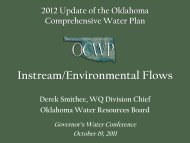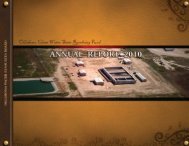kiamichi river basin water resources development plan
kiamichi river basin water resources development plan
kiamichi river basin water resources development plan
Create successful ePaper yourself
Turn your PDF publications into a flip-book with our unique Google optimized e-Paper software.
Protecting the Present and Future Water Needs of Oklahomans“The present and future needs for <strong>water</strong> by all Oklahomans shall be considered, with thehighest priority given to Oklahomans from the Kiamichi River Basin.”Although protecting <strong>water</strong> <strong>resources</strong> from the Kiamichi River Basin for users within the Basinis of utmost importance prior to the finalization of potential <strong>water</strong> <strong>development</strong> projects, HCR1066 also directs the Kiamichi River Basin Working Group to ensure Kiamichi supply for futuregrowth in other identified areas of the state. In addition to the relative abundance of existing<strong>water</strong> supplies throughout both the upper and lower Basin regions, four federal reservoirprojects remain authorized for construction in southeast Oklahoma. At this time, however,Congress has not appropriated any funds for the construction of these projects. In addition, theKiamichi River Basin Working Group does not necessarily recommend their construction.Tuskahoma (Table 7, Figure 12), the only major project which would reside within theKiamichi River Basin, has been in deferred status since 1981. The reservoir is proposed forconstruction on the Kiamichi River in Pushmataha and LeFlore Counties for the purposes offlood control, <strong>water</strong> supply, recreation, and fish and wildlife conservation. The reservoir wouldprovide flood control storage of 138,600 ac-ft and conservation storage of 231,000 ac-ft. Theestimated yield is 224,000 ac-ft/yr (200 mgd). The project was re-evaluated by the Corps ofEngineers in 1989 with hydropower as a proposed use. The recommended configuration wouldhave no flood control storage and only 49,100 ac-ft of conservation storage yielding 63,850 acft/yr(57 mgd) of <strong>water</strong> supply. While hydropower benefits indicate that the project may beeconomically justified, hydropower is not an authorized use and the project does not meetfederal criteria for participation. Potential construction of this project would be difficult due to theabundant existence of numerous endangered species, especially the Ouachita RockPocketbook Mussel, in the lake’s <strong>water</strong>shed.Parker Lake (Table 7, Figure 13), authorized by the Water Resources Development Act of1986, is a proposed impoundment on Muddy Boggy Creek in Coal County. The lake isauthorized for flood control, <strong>water</strong> supply, recreation, and fish and wildlife mitigation uses. It isestimated to have a drainage area of 164 square miles and would provide 110,300 ac-ft of floodcontrol storage and 109,940 ac-ft of conservation storage yielding 45,900 ac-ft/yr (41 mgd) ofgood quality <strong>water</strong>. Pre-construction engineering and design have been completed for theproject, but construction is on hold until a local sponsor for the <strong>water</strong> supply storage is secured.Boswell Lake (Table 7, Figure 14) is an authorized project on Boggy Creek in ChoctawCounty. The reservoir, scaled back from its original much larger size, would provide 294,100 acftof flood control storage and 60,870 ac-ft of conservation storage yielding 56,000 ac-ft/yr (50mgd) of <strong>water</strong> supply. The project is not currently economically viable, based solely on floodcontrol benefits. Should a local sponsor emerge for the <strong>water</strong> supply storage, the project couldbe reactivated.Lukfata Lake (Table 7, Figure 15) is an authorized impoundment on Glover Creek inMcCurtain County. Authorized uses include flood control and <strong>water</strong> supply. The project wouldhave 172,000 ac-ft of flood control storage and 31,000 ac-ft of conservation storage yielding69,450 ac-ft/yr (62 mgd) of excellent quality <strong>water</strong> supply. Lukfata Lake is the only impoundmentin the seven-lake system authorized for the Little River Basin that has not yet been constructed.In 1977, Congressional funding for the project was halted due to the potential adverse effect onthe habitat of the area’s Leopard Darter, a small fish on the threatened species list.


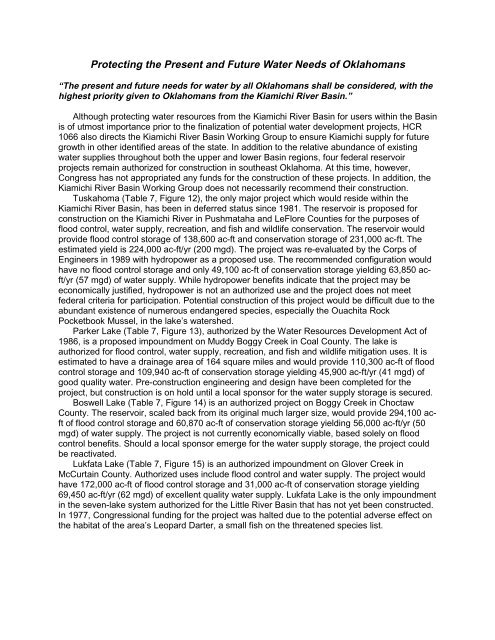

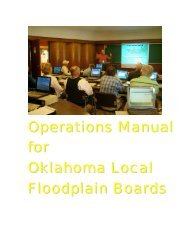
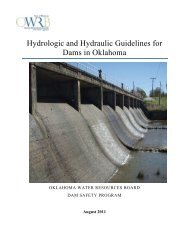
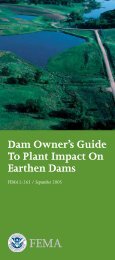




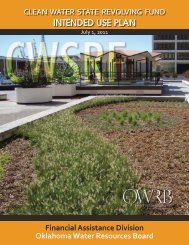


![A Commodity & a Resource [pdf] - Water Resources Board - State of ...](https://img.yumpu.com/42536671/1/190x143/a-commodity-a-resource-pdf-water-resources-board-state-of-.jpg?quality=85)
